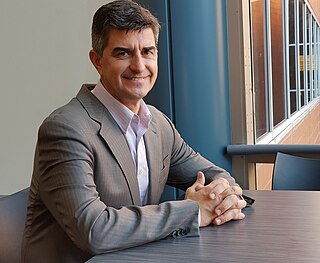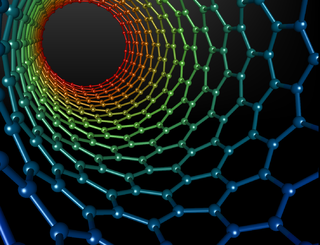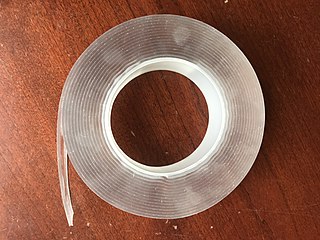
Nanotechnology was defined by the National Nanotechnology Initiative as the manipulation of matter with at least one dimension sized from 1 to 100 nanometers (nm). At this scale, commonly known as the nanoscale, surface area and quantum mechanical effects become important in describing properties of matter. The definition of nanotechnology is inclusive of all types of research and technologies that deal with these special properties. It is therefore common to see the plural form "nanotechnologies" as well as "nanoscale technologies" to refer to the broad range of research and applications whose common trait is size. An earlier description of nanotechnology referred to the particular technological goal of precisely manipulating atoms and molecules for fabrication of macroscale products, also now referred to as molecular nanotechnology.

Richard Errett Smalley was an American chemist who was the Gene and Norman Hackerman Professor of Chemistry, Physics, and Astronomy at Rice University. In 1996, along with Robert Curl, also a professor of chemistry at Rice, and Harold Kroto, a professor at the University of Sussex, he was awarded the Nobel Prize in Chemistry for the discovery of a new form of carbon, buckminsterfullerene, also known as buckyballs. He was an advocate of nanotechnology and its applications.

James Mitchell Tour is an American chemist and nanotechnologist. He is a Professor of Chemistry, Professor of Materials Science and Nanoengineering at Rice University in Houston, Texas.
The history of nanotechnology traces the development of the concepts and experimental work falling under the broad category of nanotechnology. Although nanotechnology is a relatively recent development in scientific research, the development of its central concepts happened over a longer period of time. The emergence of nanotechnology in the 1980s was caused by the convergence of experimental advances such as the invention of the scanning tunneling microscope in 1981 and the discovery of fullerenes in 1985, with the elucidation and popularization of a conceptual framework for the goals of nanotechnology beginning with the 1986 publication of the book Engines of Creation. The field was subject to growing public awareness and controversy in the early 2000s, with prominent debates about both its potential implications as well as the feasibility of the applications envisioned by advocates of molecular nanotechnology, and with governments moving to promote and fund research into nanotechnology. The early 2000s also saw the beginnings of commercial applications of nanotechnology, although these were limited to bulk applications of nanomaterials rather than the transformative applications envisioned by the field.

Carbon nanotubes (CNTs) are cylinders of one or more layers of graphene (lattice). Diameters of single-walled carbon nanotubes (SWNTs) and multi-walled carbon nanotubes (MWNTs) are typically 0.8 to 2 nm and 5 to 20 nm, respectively, although MWNT diameters can exceed 100 nm. CNT lengths range from less than 100 nm to 0.5 m.

Nanobatteries are fabricated batteries employing technology at the nanoscale, particles that measure less than 100 nanometers or 10−7 meters. These batteries may be nano in size or may use nanotechnology in a macro scale battery. Nanoscale batteries can be combined to function as a macrobattery such as within a nanopore battery.
As the world's energy demand continues to grow, the development of more efficient and sustainable technologies for generating and storing energy is becoming increasingly important. According to Dr. Wade Adams from Rice University, energy will be the most pressing problem facing humanity in the next 50 years and nanotechnology has potential to solve this issue. Nanotechnology, a relatively new field of science and engineering, has shown promise to have a significant impact on the energy industry. Nanotechnology is defined as any technology that contains particles with one dimension under 100 nanometers in length. For scale, a single virus particle is about 100 nanometers wide.
The following outline is provided as an overview of and topical guide to nanotechnology:
Green nanotechnology refers to the use of nanotechnology to enhance the environmental sustainability of processes producing negative externalities. It also refers to the use of the products of nanotechnology to enhance sustainability. It includes making green nano-products and using nano-products in support of sustainability.
Timothy S. Fisher is an American educator, engineer and expert in the application of nanotechnologies. He is a former professor of mechanical engineering at the School of Mechanical Engineering, Purdue University and Director, Nanoscale Transport Research Group-Purdue University. He currently teaches at the University of California, Los Angeles. He took his Bachelor of Science and doctorate at Cornell University in 1991 and 1998, respectively. Fisher became the chair of mechanical and aerospace engineering department at University of California, Los Angeles, starting July 1, 2018.

Mark Christopher Hersam is a professor of Chemistry and Materials Science Engineering at Northwestern University (2000–present) who, according to the National Science Foundation, has made "major breakthrough[s]" in the field of nanotechnology. He is a 2014 recipient of the MacArthur "Genius" Award and a 1996 Marshall Scholar. He is also an Executive Editor of ACS Nano. As of October 2023, he has been cited over 68,000 times according to Google Scholar.
The applications of nanotechnology, commonly incorporate industrial, medicinal, and energy uses. These include more durable construction materials, therapeutic drug delivery, and higher density hydrogen fuel cells that are environmentally friendly. Being that nanoparticles and nanodevices are highly versatile through modification of their physiochemical properties, they have found uses in nanoscale electronics, cancer treatments, vaccines, hydrogen fuel cells, and nanographene batteries.

Yury Georgievich Gogotsi is a Ukrainian scientist in the field of material chemistry, professor at Drexel University, Philadelphia, United States since 2000 in the fields of Materials Science and Engineering and Nanotechnology. Distinguished University and Trustee Chair professor of materials science at Drexel University — director of the A.J. Drexel Nanotechnology Institute.
Onkar Nath Srivastava was an Indian material physicist, an Emeritus professor of Banaras Hindu University and the vice president for India and South Asia of the International Association for Hydrogen Energy, who was known for his contributions to the disciplines of nanotechnology and hydrogen energy. He was the author of two books and over 440 scientific papers and a recipient of several honors including Shanti Swarup Bhatnagar Prize, the highest Indian award in the science and technology categories. The Government of India awarded him the fourth highest civilian honour of the Padma Shri, in 2016, for his contributions to science and engineering.
Andrew R. Barron is a British chemist, academic, and entrepreneur. He is the Sêr Cymru Chair of Low Carbon Energy and Environment at Swansea University, and the Charles W. Duncan Jr.-Welch Foundation Chair in Chemistry at Rice University. He is the founder and director of Energy Safety Research Institute (ESRI) at Swansea University, which consolidates the energy research at the University with a focus on environmental impact and future security. At Rice University, he leads a Research Group and has served as Associate Dean for Industry Interactions and Technology Transfer.
Gurpreet Singh is a professor of Mechanical and Nuclear Engineering at [Kansas State University]. He is endowed by the Harold O. and Jane C. Massey Neff Professorship in Mechanical Engineering. Singh was born in Ludhiana, India; he currently resides in the United States.

Nanotechnology in warfare is a branch of nano-science in which molecular systems are designed, produced and created to fit a nano-scale (1-100 nm). The application of such technology, specifically in the area of warfare and defence, has paved the way for future research in the context of weaponisation. Nanotechnology unites a variety of scientific fields including material science, chemistry, physics, biology and engineering.
Sharmila Mitra Mukhopadhyay is a professor of materials science and Director of the Center for Nanoscale Multifunctional Materials at Wright State University. In 2016 she was elected as a Jefferson Science Fellow, working as a science advisor to the United States Department of State.

Nano tape, also called gecko tape; marketed under the name Insanity Tape, is a synthetic adhesive tape consisting of arrays of carbon nanotubes transferred onto a backing material of flexible polymer tape. These arrays are called synthetic setae and mimic the nanostructures found on the toes of a gecko; this is an example of biomimicry. The adhesion is achieved not with chemical adhesives, but via van der Waals forces, which are weak electric forces generated between two atoms or molecules that are very close to each other. So far there is little evidence to support nano tape being recyclable in the same way as plastic bottles, but it is reusable. More data is needed to know how environmentally safe nano tape is.
Jun Li is a distinguished professor of chemistry at Kansas State University known for his research in nanoscience and nanomaterials. He is a fellow of the Royal Society of Chemistry, the National Academy of Inventors, and the International Association of Advanced Materials.









